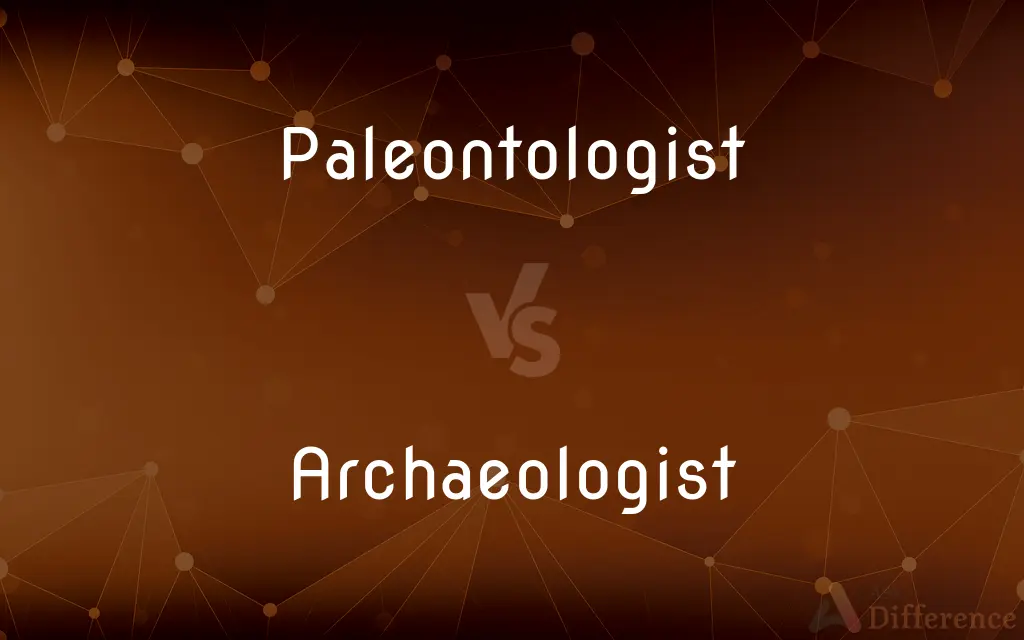Paleontologist vs. Archaeologist — What's the Difference?
Edited by Tayyaba Rehman — By Urooj Arif — Updated on May 14, 2024
Paleontologists study ancient life through fossils to understand Earth's history, while archaeologists study past human cultures through artifacts and structures.

Difference Between Paleontologist and Archaeologist
Table of Contents
ADVERTISEMENT
Key Differences
Paleontologists focus on the study of fossils, including those of plants, animals, and microorganisms, to reconstruct the biological and ecological history of Earth. On the other hand, archaeologists examine artifacts, ruins, and cultural remains to understand human behaviors and social patterns.
The timeline of interest for paleontologists spans millions to billions of years, encompassing the history of life on Earth. Conversely, archaeologists concentrate on human history, which covers roughly the last 2.5 million years since the appearance of early hominins.
Paleontologists often work in the field, extracting fossils from rock formations and then analyzing these specimens in laboratories. Archaeologists, while also conducting fieldwork, focus on excavating sites and meticulously cataloging artifacts such as pottery, tools, and structures.
Techniques used by paleontologists include carbon dating, stratigraphy, and paleographic mapping to date and contextualize fossils. Meanwhile, archaeologists employ methods like radiocarbon dating, dendrochronology, and landscape analysis to date and understand the context of human activity.
The outcome of paleontological research contributes to our understanding of evolution, extinction events, and Earth’s climatic history. In contrast, archaeological findings help illuminate historical human lifestyles, societal evolution, and cultural transitions.
ADVERTISEMENT
Comparison Chart
Focus
Ancient life forms (plants, animals, microorganisms)
Past human cultures and behaviors
Main Tools
Geological maps, carbon dating, stratigraphy
Excavation tools, radiocarbon dating, GIS technology
Study Duration
Millions to billions of years
Up to 2.5 million years (human history)
Typical Outputs
Fossils
Artifacts, structures, human remains
Contribution
Understanding of biological evolution and Earth’s history
Insights into human history, societal changes
Compare with Definitions
Paleontologist
They study the remains of ancient organisms.
The paleontologist identified the fossil as that of a new dinosaur species.
Archaeologist
They preserve historical and cultural heritage.
The archaeologist worked on preserving the integrity of the unearthed structures.
Paleontologist
They reconstruct ancient ecosystems.
Paleontologists determine past climates by examining plant fossils.
Archaeologist
They dig sites to find physical remains of past cultures.
The archaeologist led an excavation in Egypt to find new artifacts.
Paleontologist
They contribute to our understanding of life’s evolution.
Paleontologists use fossils to trace the evolutionary history of mammals.
Archaeologist
They study objects made by humans.
The archaeologist unearthed pottery shards at the ancient site.
Paleontologist
They relate fossils to rock layers to date them.
The paleontologist dated the fossil based on the rock layer it was found in.
Archaeologist
They piece together past human lifestyles.
From the artifacts, the archaeologist reconstructed the daily life of the Neolithic people.
Paleontologist
They research why species disappeared.
The paleontologist studied fossils to understand the causes of the Permian extinction.
Archaeologist
They may study living people to understand past behaviors.
The archaeologist used modern tribal behaviors to infer ancient practices.
Paleontologist
The study of the forms of life existing in prehistoric or geologic times, as represented by the fossils of plants, animals, and other organisms.
Archaeologist
The systematic study of past human life and culture by the recovery and examination of remaining material evidence, such as graves, buildings, tools, and pottery.
Paleontologist
One who studies paleontology.
Archaeologist
Someone who studies or practises archaeology.
Paleontologist
One versed in paleontology.
Archaeologist
One versed in archæology; an antiquary.
Paleontologist
A specialist in paleontology
Archaeologist
An anthropologist who studies prehistoric people and their culture
Common Curiosities
How do paleontologists date fossils?
Paleontologists often use methods like carbon dating and stratigraphy to date fossils.
What is the main focus of archaeology?
Archaeologists focus on understanding human past through artifacts and cultural remains.
What techniques do archaeologists use in their studies?
Archaeologists use excavation, radiocarbon dating, and analysis of material culture.
What type of artifacts do archaeologists find?
Archaeologists commonly find tools, pottery, and sometimes human remains.
What are some typical tools used by paleontologists?
Geological maps and carbon dating tools are commonly used by paleontologists.
What do paleontologists study?
Paleontologists study fossils to understand ancient life forms and Earth’s history.
Can archaeologists and paleontologists work together?
Yes, their fields occasionally overlap, especially in studies involving very ancient human remains.
How do archaeologists help preserve history?
Archaeologists not only uncover past artifacts but also work to preserve them for future study and education.
What educational background is needed to become a paleontologist?
A degree in geology or biology, often followed by specialized training in paleontology, is typical.
What can paleontology tell us about climate change?
Paleontology provides insights into past climate conditions and how they affected life on Earth.
Can modern technology affect paleontology and archaeology?
Advances in technology, like 3D scanning and GIS, significantly enhance research capabilities in both fields.
What is the significance of archaeological sites?
Archaeological sites offer invaluable insights into past human activities, societies, and cultures.
What role do museums play for archaeologists and paleontologists?
Museums serve as repositories for artifacts and fossils and as educational platforms for the public.
Why is understanding extinct species important?
It helps scientists understand evolutionary processes and how ecosystems have changed over time.
What is the difference in the time periods studied by paleontologists and archaeologists?
Paleontologists study time periods that can span billions of years, while archaeologists focus on human history, which spans up to 2.5 million years.
Share Your Discovery

Previous Comparison
Butter vs. Cream
Next Comparison
Grass vs. SedgeAuthor Spotlight
Written by
Urooj ArifUrooj is a skilled content writer at Ask Difference, known for her exceptional ability to simplify complex topics into engaging and informative content. With a passion for research and a flair for clear, concise writing, she consistently delivers articles that resonate with our diverse audience.
Edited by
Tayyaba RehmanTayyaba Rehman is a distinguished writer, currently serving as a primary contributor to askdifference.com. As a researcher in semantics and etymology, Tayyaba's passion for the complexity of languages and their distinctions has found a perfect home on the platform. Tayyaba delves into the intricacies of language, distinguishing between commonly confused words and phrases, thereby providing clarity for readers worldwide.
















































